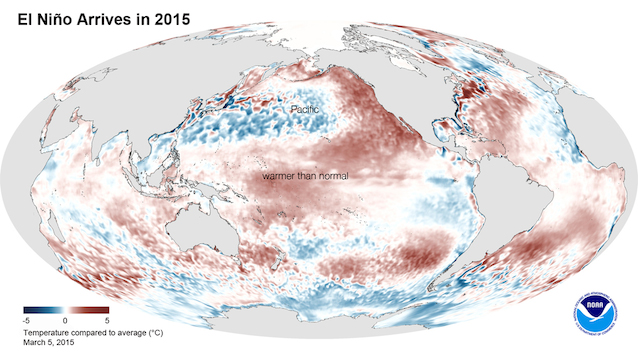
The National Oceanic and Atmospheric Administration (NOAA)
has announced that the long-awaited El Niño has arrived. NOAA’s Climate
Prediction Center says we now have “borderline, weak El Niño conditions,” and
there is a “50-60% chance that El Niño conditions will continue” through the
summer.
An El Niño is “characterized by unusually warm ocean
temperatures in the Equatorial Pacific,” as NOAA has explained. That contrasts
with the unusually cold temps in the Equatorial Pacific during a La Niña. Both
are associated with extreme weather around the globe (though a weak El Niño
like this will tend to have a muted effect). El Niños tend to set the record
for the hottest years, since the regional warming adds to the underlying global
warming trend. La Niña years tend to be below the global warming trend line.
If even a weak El Niño does persist through summer, 2015
will almost certainly top 2014 as the hottest year on record. But there is a
good chance it will do so in any case (unless a La Niña forms). After all, 2014
was the hottest year on record even though there was no official El Niño during
the year.
Significantly, because 1998 was an unusually strong “super
El Niño,” and because we haven’t had an El Niño since 2010, it appeared for a
while (to some) as if global warming had slowed — if you cherry-picked a
relatively recent start year (and ignored the rapid warming in the oceans,
where 90 percent of human-caused planetary warming goes). In fact, however,
several recent studies confirmed that planetary warming continues apace
everywhere you look.
The most obvious early signs of this in the Baja are that
the Gray whales have started their return migration a few weeks early. Traditionally
, the whales start their return on the first or second week of March , but due
to El Niño , they are already leaving said the regional director of the
National Commission of Natural Protected Areas , Benito Bermudez.
He said that about 3,300 whales and calves that were in the
Scammon , Black Warrior and San Ignacio lagoons , however there are now just
under 2,000.